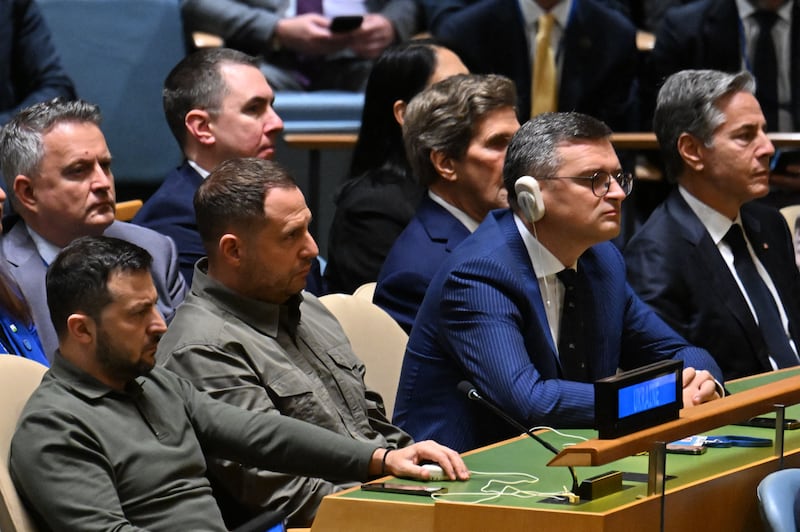Nato is drawing up plans to secure a five-year military aid package of up to $100 billion (€93 billion), in an attempt to shield Ukraine from “winds of political change” that could usher in a second Trump presidency.
The so-called Mission for Ukraine proposal, which will be discussed by Nato foreign ministers on Wednesday, is being put forward by the secretary general Jens Stoltenberg.
According to five alliance diplomats briefed on the plan, it would co-ordinate an estimated $100 billion in support committed by the 32 members of the military alliance.
Mr Stoltenberg has pitched the proposal as a means “to shield the mechanism against the winds of political change”, according to people briefed on his remarks.
READ MORE
If approved, it would also give the alliance control of the US-led Ramstein weapons support group and allow it to manage the supply of lethal weapons to Ukraine for the first time since Russia’s full-scale invasion in 2022.
The Norwegian secretary general, who will step down from his role this autumn, is aiming to reach agreement before the Nato leaders’ summit in Washington in July.
“This will be crossing a Rubicon. Nato will have a role in co-ordinating lethal support to Ukraine,” said one of the diplomats. “I see consensus emerging and I think it will be there by the time we get on the plane to Washington.”
The mission proposal comes as the Biden administration struggles to get approval from Congress for a bilateral $60 billion Ukraine military support package – which Republican front-runner Donald Trump has openly spoken against – in advance of the presidential election in November.

Many allies see the stalemate as a harbinger of how US policy towards Kyiv would shift under a Trump presidency.
It has been drawn up as Nato allies fret about the state of the conflict in Ukraine, where Russia has regained the initiative on the ground, outmanning and outgunning Ukrainian forces.
The US share of the $100 billion would be significantly less than the bilateral aid package being held up, the diplomats said. Debates are ongoing about the structure of financing, with some pushing for the same breakdown used to fund Nato’s shared budget – under which the US would need to provide a little over $16 billion.
“$100 billion for the next five years to support the Ukrainian force of the future,” said the diplomat, who said that the Nato joint budget coefficients could be used to calculate individual shares of the total spending. “It solves a burden-sharing problem.”

It is envisaged as a means both to lock in long-term financing in advance of Mr Trump’s potential election and to give Kyiv a concrete deliverable from the summit, in lieu of progress towards its desired membership of Nato, which is seen as impossible by many alliance members.
“Foreign ministers will discuss the best way to organise Nato’s support for Ukraine, to make it more powerful, predictable, and enduring,” a Nato official said, adding that discussions were expected to continue in the run-up to the July summit.
At present, much of the western weaponry provided to Ukraine is managed by the US-led Ramstein Group, officially known as the Ukraine Defense Contact Group, which meets regularly to discuss how best to co-ordinate bilateral deliveries.
[ Ukraine says it downed two of three Russian drones overnightOpens in new window ]
Two of the diplomats cautioned that the proposal would require the backing of all 32 members and there were likely to be months of negotiations ahead, in which parts of the proposal could be scaled back.
One person familiar with the matter described Mr Stoltenberg’s proposal as “fairly nascent” and said allies had asked the Nato chief for more information. The person said there were discussions about Nato becoming more involved in the Ramstein process, but no decision had yet been made. Meanwhile questions – such as whether countries’ existing bilateral aid provision would count towards the $100 billion – still remained.
Some resistance is expected from states that have opposed providing weapons to Ukraine, such as Hungary, and those that have been wary of any steps that would give Nato, or imply, a direct role in the conflict. Russian president Vladimir Putin has sought to portray the conflict as a war between Russia and Nato.
“We are continuing to work with our friends in Europe and Canada to ensure that support [to Ukraine] will keep flowing. That is the focus inside Nato HQ. I don’t see anyone letting their foot off the gas,” said Julianne Smith, US ambassador to Nato. “I see countries coming forward with fresh ideas every week ... I expect that to be the focus of the ministerial that starts tomorrow.” – Copyright The Financial Times Limited 2024












